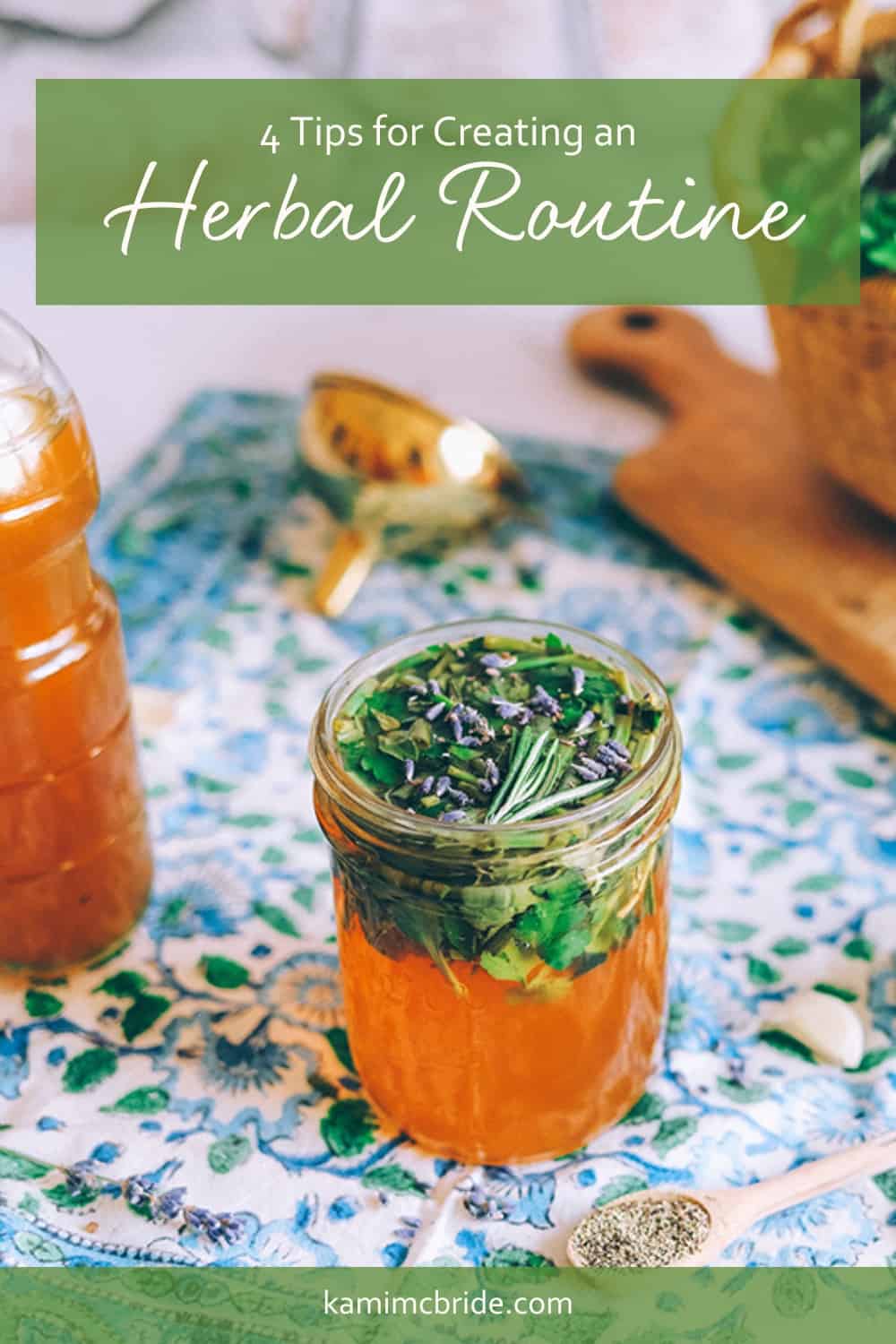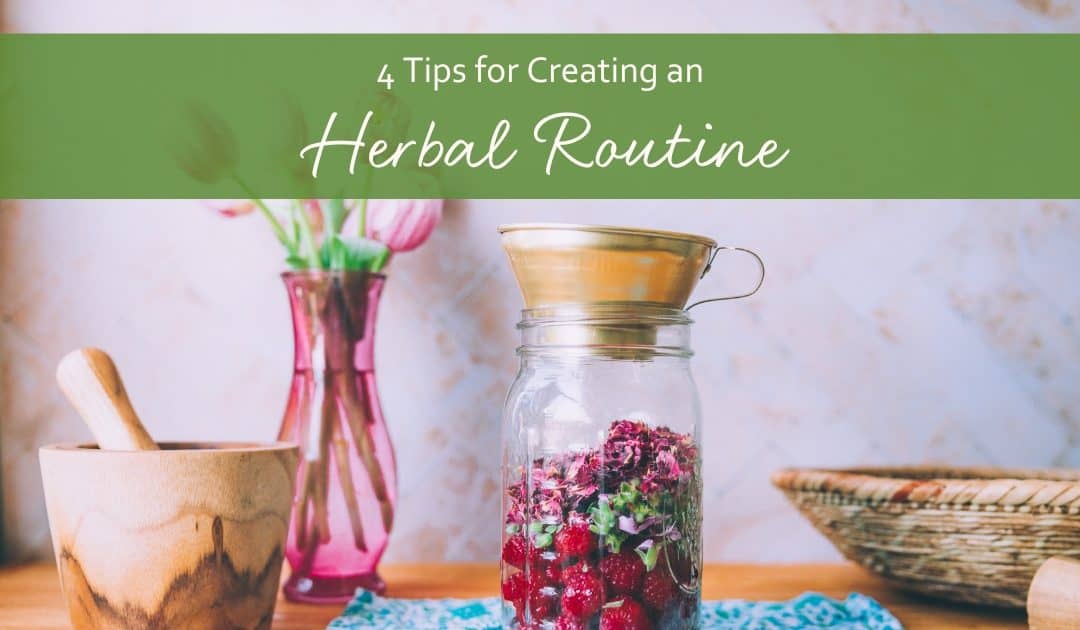As an herbalist, I talk to many people about health. The conversation eventually leads to questions about what to do for a sick child, friend, or family member or how to prevent them from becoming ill. Since food is one of our primary medicines, I always begin with exploring what a family eats that either invites or deters illness. By creating an herbal routine, you can bring healing into your everyday life.
“By creating an herbal routine, you can bring healing into your everyday life.”
What I have noticed is that today fewer women cook, and especially many younger women possess less comprehensive cooking skills than women their age twenty years ago. It is surprising how many women begin our sessions by saying “I don’t cook.” The pervasiveness of convenience meals has contributed to a way of life that continually erodes our food and body knowledge base.
As more and more of our meals come neatly wrapped in neon-colored packages, the meat and vegetables are watered down with cheap oils, and the spices are replaced by chemicals. The imposter spice additives deceive our taste buds into craving fraudulent foods that are an assault to our physical strength and intelligence. Food becomes a burden to our body instead of a source of vitality. We lose our sense of taste for what nourishes a strong body. We disassociate with where our food comes from or what it takes to prepare it. I have heard children say that their food comes from a vault under the grocery store.
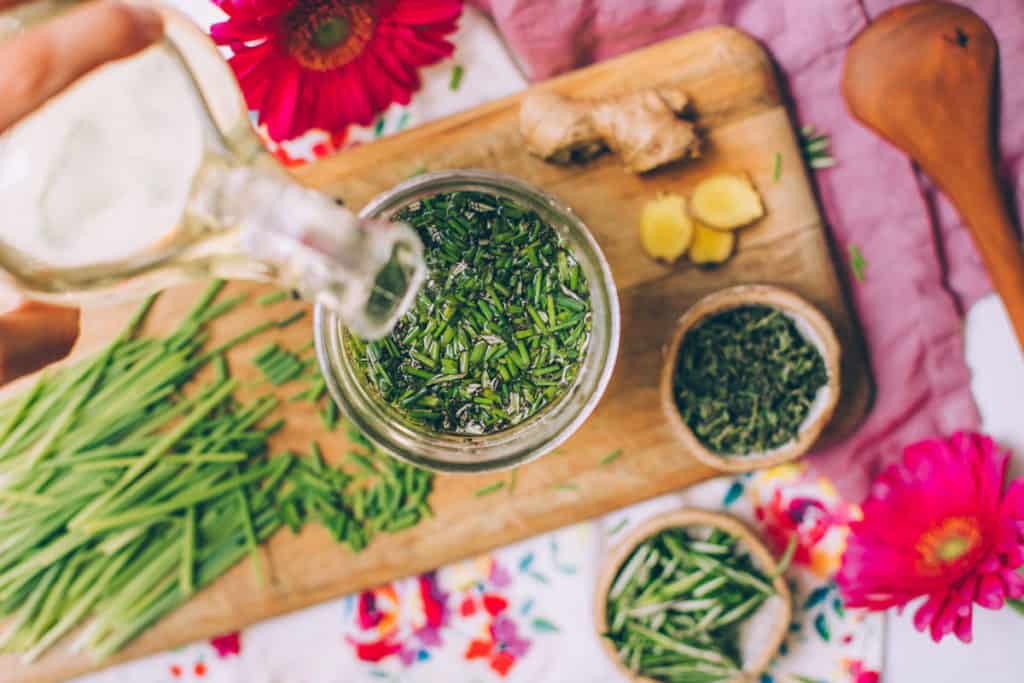
Benefits of an Herbal Routine
One of the many advantages of increasing your herb quotient in meal preparations is the vitamin and mineral content of herbs and spices. The spice cabinet and garden are abundant in mineral-rich herbs. Chemical farming practices have depleted the soil of nutrients that would normally transfer into our vegetables. The breadth of flavor in a vegetable is an indicator of its mineral content. Mineral-rich vegetables have a full, sweet taste. Vegetables devoid of minerals taste like nothing; I refer to them as cardboard vegetables.
“One of the many advantages of increasing your herb quotient in meal preparations is the vitamin and mineral content of herbs and spices.”
Many chronic diseases develop from nutrient deficiency. With the widespread consumption of prepackaged and conventionally farmed foods, we are experiencing the phenomenon of being overfed yet undernourished. Eat fresh, whole, organic, and locally grown food and add herbs and spice rack remedies to as many meals as possible.
I spend a significant amount of time with students and clients exploring strategies for how, when, and what to eat. This basic knowledge of nourishing ourselves is absent from so many people’s lives. If you weren’t raised with the appreciation of homemade, well-spiced, whole foods, it can be an overwhelming task to learn from scratch. Here are four strategies for building a lasting herbal routine and culture for you and your family.

Lean on Community
Having an herbal kitchen is about the personal and communal joy of putting nature in your cupboard. It is about reclaiming the indispensable skill of using herbs to prevent sickness and take care of home ailments. Nurturing the life around us with the medicine from the kitchen revives our relationship with the plants and empowers our ability to understand our food, our body, and our relationship to sustaining healthy life.
“Having an herbal kitchen is about the personal and communal joy of putting nature in your cupboard.”
For me, this information is much easier to embody when I share it with another person. Many of my students have an herbal routine where they get together once a season and mix their oils, set up tinctures, and make seasonal foods and herbal remedies. Please don’t put herbal recipes on your to-do list as one more thing adding to the compression of overstimulation and activity. They should be a fun and relaxing opportunity to connect with those around you. What about a monthly herbal crafting get-together with even one other person who is interested in health?
Not everyone needs to be the cook, but all of us need someone in our life who is focused on what happens in the kitchen. I envision a culture where there is more meal sharing between families so that our food preparation can become more sustainable. Three families on one block can do meal trades, or group cooking days can produce meals for the week.
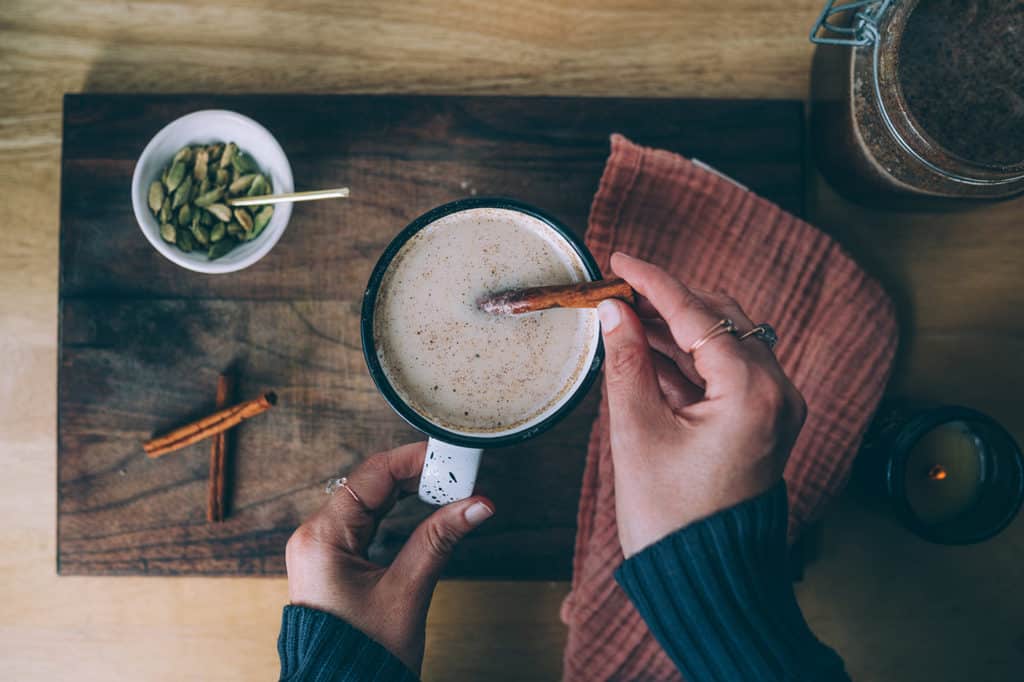
Look for a Rhythm
If you are overwhelmed with all of life’s tasks, just begin by setting aside one afternoon a week for embracing food culture with your family. Like everyone else, our days are busy, but Wednesday afternoons from about three to five thirty, we play in the kitchen. We make pesto from explosions of basil, pies from summer apricots, juice from fall apples, and nut butter from the almond harvest, and pomegranate juice flows all winter long.
Once you establish a weekly food preparation ritual, it becomes habitual, and you miss it when it doesn’t happen. This part of your herbal routine becomes the time to strain out the herbal oils, stock your pantry with herbal vinegars, whip up a new batch of herbed ghee, or make a special marinade for the evening meal.
When there is a profusion of lavender in the garden, we store the seasonal harvest by making vinegars, oils, cordial, and many other condiments that enrich our meals. Ripe elderberries means black fingertips and a case of cordial. It is amazing what you can do in even a few hours a week. Set a time and create a rhythm, a food culture rhythm that will feed you and your household in more ways than you can name.
“If you are overwhelmed with all of life’s tasks, just begin by setting aside one afternoon a week for embracing food culture with your family.”
Stop and think right now about a structure that can help support you into really being able to incorporate more food preparation time into your life. It doesn’t have to be a lot of time; look for a rhythm and find a way to be supported in that rhythm.
It is a little bit like exercising: if you have a buddy, you are more likely to stick with it. This makes sense, because it is only a recent phenomenon that solitary people cook for just themselves or others. It is really not in our cellular memory to be alone in the kitchen. We always cooked in groups. Our current template of having one person as the main nurturer in a single-family household is really a new experiment. I don’t know about you, but for me, cooking alone is a task. As soon as there is another person in the kitchen, it is fun!
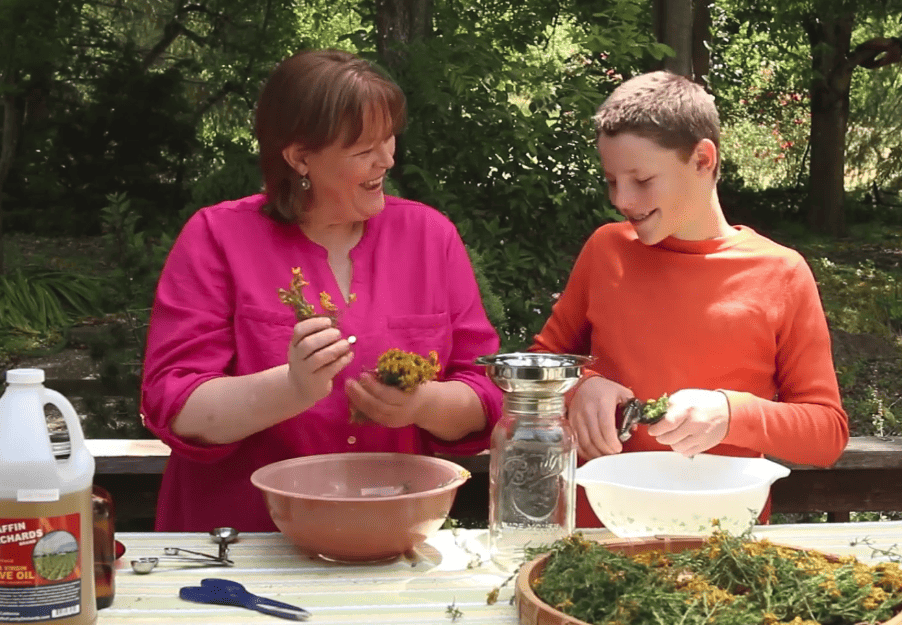
Involve Your Children
Involve your children in your herbal routine. Provide them with simple ways to incorporate herbs into their food and cooking projects. Let them be in charge of garnishing their foods with herbs. We always have several herb sprinkles on the table that my son can use at any time. In classes I pass around a platter of little herb-filled bowls.
People are usually inspired by the idea and, without much effort, put herbal condiments on their kitchen table for everyone to use. The feedback from introducing just this one little trick is amazing. People tell me how their kids are now using all kinds of herbal condiments and love sprinkling cinnamon on their oatmeal and rose hips on their rice.
“Involve your children in your herbal routine. Provide them with simple ways to incorporate herbs into their food and cooking projects.”
Children develop their taste preferences when they are young. Make it convenient for them to have opportunities to use herbs. Feed them now what you want them to eat throughout their lives.
My son did not have one speck of processed sugar in his first year. At five years old, he has still never eaten boxed macaroni and cheese. He sprinkles herbs on almost all of his meals and picks his own peppermint tea when he has a bellyache.
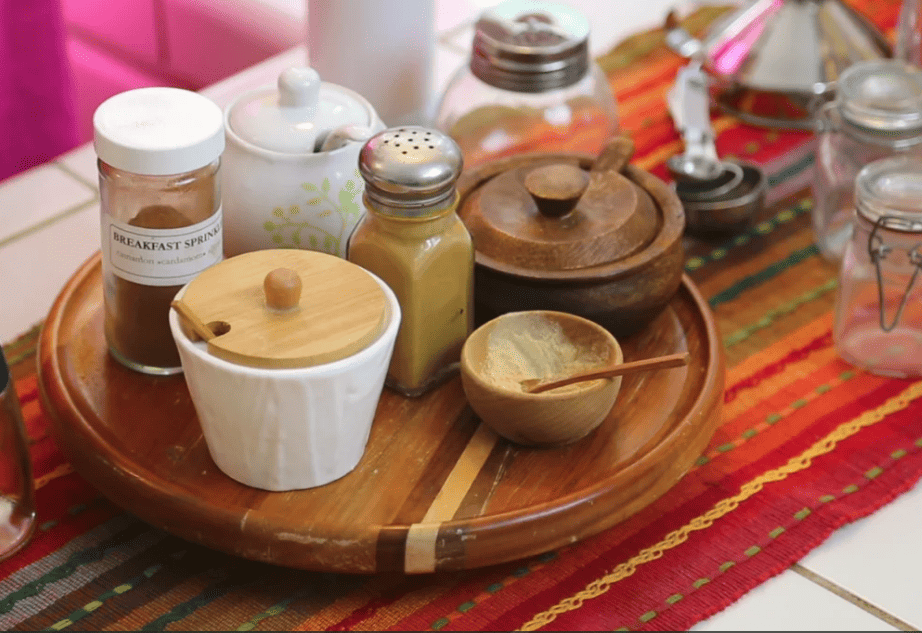
Stock Your Pantry
Another important part of having an herbal routine is increasing your access to herbs. Hopefully you will be inspired to fill your pantry to its holding capacity. Get ready to add more shelves to your kitchen storage area. Sacrifice a cabinet of dishes for more condiment space or remodel your kitchen just a little so it can house your herbal alchemy projects.
What about all the bottles, jars, lids, strainers, teapots, and other paraphernalia? Build shelves above your cupboards; put standing cabinets in the garage, the spare bedroom, or a closet. Add a spice rack to the back of the kitchen door.
“Creating an herbal routine is easy once you have your herbs and herbal blends organized and readily accessible to add to foods and beverages as often as possible.”
When my husband and I went to look at the house we would live in for ten years, I said, “Oh yes, very nice, three bedrooms, two bathrooms, uh huh but look at the granny flat, just behind the house! It is the perfect place for all my jars, bottles, and herbal infusions.” It was heaven, an entire building for all of the infusing, fermenting, aging, soaking, macerating, percolating, mixing, marinating, and drying that takes place with my food and herbs. We have since moved to a place that doesn’t have a second building, but the herbs now have their own bedroom, and they also dominate the garage.
Creating an herbal routine is easy once you have your herbs and herbal blends organized and readily accessible to add to foods and beverages as often as possible. Keep a variety of herbal condiments next to your food preparation area as well as on your table. You can put powdered herbs in salt and pepper shakers or in tiny bowls with miniature spoons for sprinkling on your food. I am always looking to support our meals with herbs in as many ways as possible. Make up a half dozen oils and vinegars and have them on hand to support you in the kitchen.
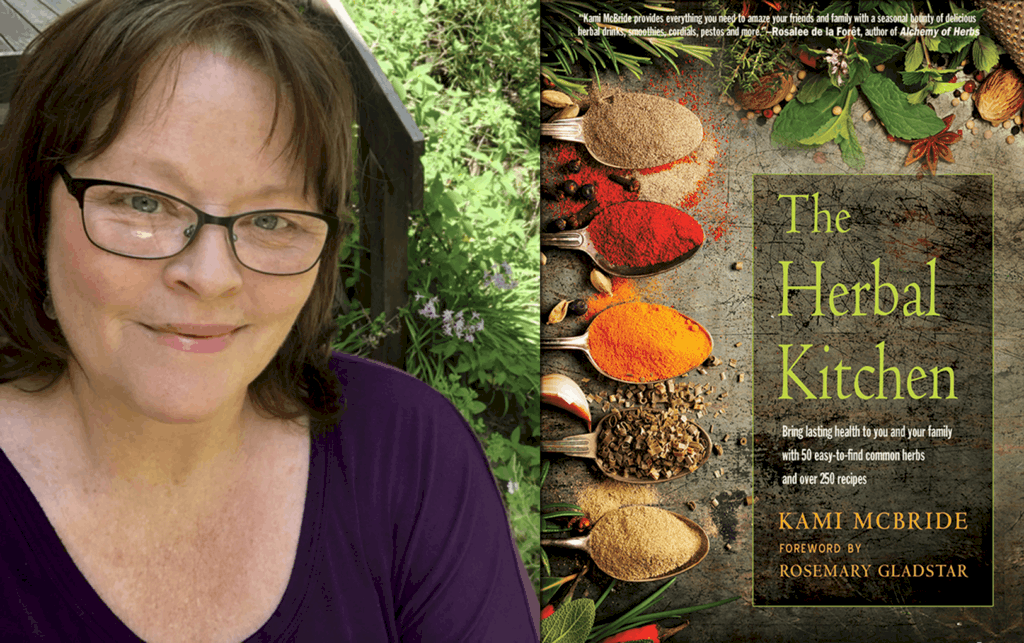
Some days you may not have a creative flow going, or your garden isn’t producing yet, or you didn’t get to the market for fresh ingredients. Let the herbal oils, vinegar, ghee, and sprinkles give you a hand. Incorporate herbs into your oils, vinegars, honey, and butter, and soon your food will encompass gourmet seasonings that taste delicious and keep your family healthy.
I created the recipes in The Herbal Kitchen to be simple and for everyone, both seasoned healthy eaters and those who are looking to make a change for the better in their dietary habits. With over 250 recipes for herbal oils, vinegars, pestos, dressings, salts, cordials, syrups, smoothies and more, The Herbal Kitchen provides the information necessary to prepare, store, and use herbs, and create a long term healthcare plan.
You can get your copy of The Herbal Kitchen here
You can get the online companion course for The Herbal Kitchen here
